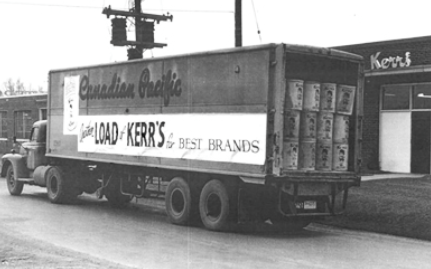It’s available only in Canada. It’s available only during Halloween. No one seems to ever like them, but it mysteriously sells-out of stores every year…Canada’s love-hate relationship with a 75 year old candy that is an endearing seasonal confection: The Kerr’s Molasses Candy Kiss.
Kerr’s is a Canadian candy company that first offered products in 1895. Their website states that the company was founded by Edward and Albert Kerr after they immigrated from Scotland to Canada.

The Scottish Molasses Candy that may have been the inspiration for Canada’s most contested candy. (Image: Ebay.com)
In Scotland, the molasses candy kiss was made by Stewart and Young in Glasgow under “The Steamship Brand”. Perhaps these sticky, tooth pulling candies were harvested from the depths of a Scottish bog. Kerr’s would use their Scottish angle in their branding with their highly recognizable Scottish “tartan” packaging, a uniquely Canadian brand. But it would not be until the 1940s that Kerr’s would venture into the bizarre world of hard, chewy molasses candies that would find their way into the bottom of Canadian trick-or treaters bags each Halloween.
The Kerr’s website details what is exactly in these “molasses Candy Kisses” and in all honestly, they sound very wholesome and a most natural kind of candy. They use an original recipe made with 10% real molasses, no artificial colours, real sugar (not the usual cheaper high fructose corn syrup), no modified or hydrogenated fats or oils, and they are peanut free, tree-nut free, gluten free, vegetarian & Halal. By all intent, this sounds like a great candy…but why do so many of us Canadians say we dislike them and yet it still is available each year? Is it because of nostalgia we can never get rid of it like an old pair of slippers? According to Kerr’s company President, “Molasses Kisses are a Canadian Halloween tradition,” but also admits that the love of this treat within the Kerr’s company hovers around the 50% mark.

Even though most of us Canadian kids would turn our noses up at these morsels in our Halloween candy sacks, these tar-like candies have miraculously increased in production each year to meet increasing demand, which leads me to believe there is some cult like following of this product similar to the bizarre people that like that Thrills gum that tastes like soap.

The first mention of a molasses candy recipe can be found in the Official cookbook of the White House circa 1887. (Image: Google)
So why make a molasses candy that could be one molecule apart from the tar putty used to patch cracks in asphalt? The history of the molasses candy kiss dates back to 1887 where the earliest mention I could find of the candy was in the Official White House Cook Book. Listed under “Dessert Candy” the White House may have been the source of this sweet scourge to find its way into our loot bags, making the molasses treat popular. This candy in the US would be labeled more popularly as “Tootsie Rolls”, whose lineage traces back to World War 2 when they were included in American field rations, since their toughness allowed them to survive a variety of environmental conditions on the frontlines.

Did World War 2 GI rations spawn the candy that became a ghoulish Halloween treat? (Image History.com)
Perhaps then it is not coincidence that Kerr’s would also introduce their version of a molasses candy during World War 2 with their own molasses treat. Was it like Silly Putty and accidentally invented in a confectionary lab that would later be used to seal tire punctures on operational war vehicles during battle? Who knows. But it did become a tradition to get these molasses candies every Halloween, a bargaining item during “tradesies” of a candy haul after a night trick-or-treating.

Kerr’s began manufacturing and distributing their molasses candy during World War 2. (Image: Kerr’s website)
Now proudly in its 75th year of production, the Kerr’s Candy Kiss with its distinctive orange, yellow and black wrapper seems to defy the marketing odds, a treat for the molasses masses. For better or worse, the Molasses Candy Kiss will remain a part of Canada’s bizarre collective cultural enlightenment, sitting proudly up there with Ketchup Chips, cheese curds, Kraft Dinner, and our need to put vinegar on French fries.

Canada’s one and only Halloween treat…love it or hate it, it is part of our culture. (Image: Kerr’s website)
So this Halloween if you get a Kerr’s Candy Kiss, don’t grimace in disgust, embrace its uniquely Canadian heritage and maybe melt it into your Tim Horton’s coffee for a truly Canadian seasonal treat, eh?
Andrew King, October 2017
SOURCES
http://www.kerrs.com/single-post/Kerrs-Molasses-Kisses-The-Best-or-Worst-Halloween-Tradition














